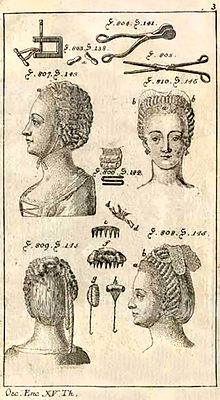Papillote
In French, the papillote actually refers to a praline or candy individually wrapped in heart or butterfly-shaped paper wraps. This was transferred to paper hair rolls. A strand of hair twisted into a curl of six is wrapped in paper and pressed. "Papillotated" curls were worn by men from the end of the 12th and beginning of the 13th century.
From the 18th century a heated papilla iron (also hairdressing iron or squeeze iron ) was used for pressing . The iron had to be heated over and over again in a warmer . The wrapping and pressing procedure could drag on for several hours. The economic encyclopedia of Johann Georg Krünitz describes the process in detail:
“After cutting the hair, use the corner of the hairstyle comb to gather some hair from a single layer, and then bend the tip of this trimmed side of hair into a curl around which a triangular piece of paper is folded, and then after that Twist the back of the head together so that the hair = curl does not run back again. These are called the curls = papers (papillores), and the wrapping of the hair in such papers is called papillotation. When the hair is wrapped around the head, it is burned. The hairdresser has two different types of iron for this purpose. One, the Frisir = iron, the squeeze iron, or the burning tongs, Fig. 804, is like a pair of tongs, and at the end is made with two jaws which are smooth on the inside. [...] The squeeze. Iron never has to be heated over coals, but constantly in the embers. When it has the necessary heat, which one recognizes when a piece of paper no longer burns black, one papillot after the other is grasped between them and pressed a little, either for a shorter or longer time, after the iron is more or less hot is; but it is better to use it as hot as the hair suffers, because then one can burn every papillote in a shorter time. For this reason it is customary to have several of the same irons and to put them in the fire if one wants to burn the hair all over the head. The hair of this shape remains curled up like natural curls for several hours, since the heat has driven out a part of the material of the hair, whereby it is forced to bend until the shortened hair = fibers and emptied marrow = vesicles of Reach their elasticity from the blood, or from the moisture of the air, swell up, and completely destroy the frizz (hairstyle). Even the shock of the wind, and all movements, stretch the hair straight out again like a dry sponge extends from the water. If, however, the hair is burned too often, it gradually loses all its elasticity, it becomes powerless, its luster and roundness disappear, it breaks before time, and the head becomes so thin that you get instead of your own hair to put on a wig. "
The traditional pejes , the twisted sidelocks worn by Orthodox Jews, are called papillotes in French .
In modern usage, the papillote is a cylindrical foam stick used to hold coiled wet hair in place until it is dry. It is comparable to the hair curler , but flexible and much longer. With these special curlers you can create irregular, naturally falling waves and curls (in contrast to the classic curlers). Thin papillots are suitable for thin hair, thick ones for thicker hair.
See also
literature
- Ingrid Loschek: Reclam's fashion and costume lexicon. 5th edition. Reclam, Stuttgart 2005, ISBN 3-15-010577-3 , p. 389

